Early 1900 Men's Fashion No Jacket
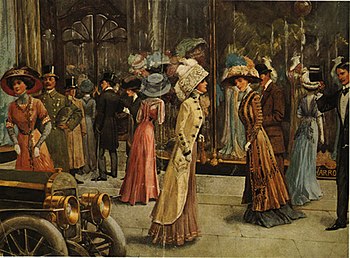
Stylish Londoners in front of Harrods, 1909. The abaft skirts which were very tight showing pare and broad-brimmed hats of mid-decade narrower dresses and hats with deep crowns. Men wearable superlative hats with formal morning wearing apparel or bowlers with lounge suits.
Fashion in the catamenia 1900–1909 in the Western world continued the severe, long and elegant lines of the belatedly 1890s. Tall, stiff collars characterize the flow, equally do women's broad hats and total "Gibson Girl" hairstyles. A new, columnar silhouette introduced by the couturiers of Paris late in the decade signaled the approaching abandonment of the corset every bit an indispensable garment.
Women's fashion [edit]
General overview [edit]

Young women adopted the tall, potent collars and narrow neckties worn by men
(advertisement for Arrow shirt collars)
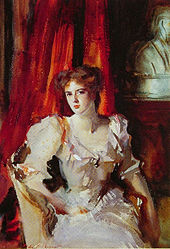
John Singer Sargent's portrait of Miss Eden shows a fashionable full breast, low neckline, and mass of hair, 1905.
With the decline of the bustle, sleeves began to increase in size and the 1830s silhouette of an hourglass shape became popular once more. The stylish silhouette in the early on 20th century was that of a confident woman, with full low chest and curvy hips. The "wellness corset" of this period removed pressure level from the abdomen and created an S-curve silhouette.[1]
In 1897, the silhouette slimmed and elongated past a considerable amount. Blouses and dresses were full in front and puffed into a "pigeon breast" shape of the early 20th century that looked over the narrow waist, which sloped from dorsum to front and was frequently absolute with a sash or belt. Necklines were supported by very loftier boned collars.[2]
Skirts brushed the floor, oftentimes with a railroad train, fifty-fifty for day dresses, in mid-decade. The manner houses of Paris began to show a new silhouette, with a thicker waist, flatter bust, and narrower hips. By the end of the decade the most fashionable skirts cleared the floor and approached the ankle. The overall silhouette narrowed and straightened, outset a trend that would continue into the years leading up to the Bang-up State of war.
In early 1910, a survey of wealthy high school senior students at a private New York City girls' schoolhouse found that each spent an average of $556 ($fifteen,443 as of 2017[update] [3]) annually for clothing excluding undergarments, and would have spent four times that amount with an unlimited budget.[4]
Sportswear and tailored fashions [edit]
Women moving out of the Victorian era and into the Edwardian era were starting to dress for a more agile lifestyle. The evolving times brought a new fashion tendency known as the "New Woman". Agile lives required less constricting clothing and required simpler and more streamlined wear. The new adult female was highly encouraged by women'south suffrage. Women that identified with this fashion movement were the type of women that were beginning to venture out of maintaining the domestic circle and brainstorm to pursue higher instruction, office jobs, and participating in active outdoor sports. The new and improved fashions allowed for women to swing a tennis dissonance, whack a golf game ball, but the ideas of "proper" feminine attire reduced the progress of more practical sportswear.
Tailored suits became more pop for the women that were beginning to piece of work in white neckband jobs. Tailored suits with no frills allowed for women maintaining an function task to seem more masculine and alloy into the male dominated environment. Soon the number of women attention colleges increased, and the shirtwaist became popular amid the average higher daughter. The outfit worn by the typical higher girl was a brim that was unremarkably shorter than current fashion, and a shirtwaist, which is best described as the equivalent of jeans and a T-shirt today.[5] [half-dozen]
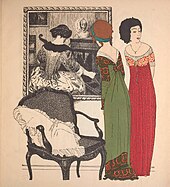
Paul Poiret's new silhouette of 1908 was a radical deviation.
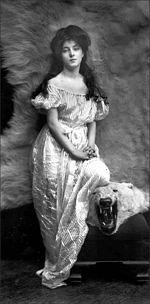
Evelyn Nesbit, in this photograph taken in 1901, has some of her wavy hair swept up to the top of her caput, with the residuum of her hair flowing past her shoulders in curling tendrils.
Unfussy, tailored apparel were worn for outdoor activities and traveling. The shirtwaist, a costume with a bodice or waist tailored like a man'southward shirt with a high collar, was adopted for informal daywear and became the uniform of working women. Wool or tweed suit (clothing) called tailor-mades or (in French) tailleurs featured ankle-length skirts with matching jackets; ladies of fashion wore them with fox furs and huge hats. Two new styles of headgear which became popular at the turn of the century were the motoring veil for driving and sailor hats worn for tennis matches, bicycling and croquet.[7]
Ascension of haute couture [edit]
This decade marked the full flowering of Parisian haute couture as the arbiter of styles and silhouettes for women of all classes. Designers sent style models or mannequins to the Longchamp races wearing the latest styles,[8] and manner photographs identified the creators of individual gowns.[ix] In 1908, a new silhouette emerged from Callot Soeurs, Vionnet at the business firm of Doucet, and virtually importantly, Paul Poiret.[10] The styles were variously called Merveilleuse, Directoire, and Empire later the fashions of the turn of the nineteenth century, which they resembled in their narrow skirts and raised waistlines.
The new styles featured form-fitting gowns with high or undefined waists, or ankle-length skirts and long tunic-like jackets, and required a different "straight line" corset. The Paris correspondent for Faddy described this new wait every bit "straighter and straighter ... less bust, less hips, and more than waist...how slim, how graceful, how elegant...!"[11]
Hats [edit]
Huge, broad-brimmed hats were worn in mid-decade, trimmed with masses of feathers and occasionally complete stuffed birds (hummingbirds for those who could afford them), or busy with ribbons and bogus flowers. Masses of wavy pilus were stylish, swept up to the top of the head (if necessary, over horsehair pads called "rats") and gathered into a knot.[12] Large hats were worn with evening article of clothing.
By the end of the decade, hats had smaller drooping brims that shaded the face and deep crowns, and the overall top-heavy effect remained.
Footwear [edit]
Shoes were narrow and often emphasized. They had a pointed toe and a medium elevation heel. Buttons, patent leather, and laced models of the shoe were also manufactured and readily available. Similarly, in that location were shoes for every occasion; oxfords for a tailored costume, slippers with straps for festive occasions or pumps with pearl buckles, and finally, boots which were oftentimes edged in fur to stave off the winter chill when riding in a wagon in the winter.[thirteen] At the beginning of 1900s shoes even so maintained the same pattern of the Victorian era. Shoes were usually made with seal skin or Moroccan leather. Having boots fabricated of seal pare was most common for people in a higher social class. Seal skin boots were known to be extremely durable and could be worn during every season. Boots made from Moroccan leather were more uncomfortable and potent. World War I acquired this opulent era to tone down due to the increased sanctions on the merchandise of leather and other fabrics, and shoes were starting to incorporate a cloth topping.[6]
Manner gallery 1900–1906 [edit]
-

one – 1900
-

ii – 1901
-

three – 1902
-

4 – 1903–04
-

5 – 1904
-

6 – 1905
-

seven - c. 1905
-

eight – 1906
-

nine – 1906

Cartoon in Dial (1911) compares changes in way between 1901 and 1911. "The dowdy voluminous wearing apparel of the earlier date, making the grandmother an sometime lady and the mother seem manifestly, had been replaced past much simpler looser article of clothing producing a sense of release for all three females."[14]
- Mrs. Charles Russell wears a sheer patterned apparel with fullness at the front waist over a soft sash. This dress might have been called a tea gown at this time (1900).
- Fashion analogy for Summer 1901 shows sloped waistline, "pouter pigeon" front bodices, high necklines and large hats with ribbons.
- Photo of three sisters c. 1902 illustrates the "pouter dove" blouse or shirtwaist and trumpet-skirt that was a mainstay of heart-class habiliment.
- Underwear (camisole (or, more than likely, peak half of combinations), corset, and trumpet-shaped petticoat) of 1903–04.
- Style plate shows the frothy trained afternoon clothes descended from the tea gown, worn with an oversized lid and gloves, 1904.
- Elizabeth Wharton Drexel wears an off-the-shoulder orange evening gown with long gloves, 1905.
- Mrs. John Philip Sousa wears a checked suit with elbow-length sleeves and long gloves, and carries a muff purse, c. 1905.
- French dress of 1906 is trimmed with embroidery or passementerie. The broad-brimmed hat is artsy up on one side. Elbow-length sleeves are worn with gloves.
- Summer evening fashions of 1906 take short or three-quarter-length sleeves. Some ladies wear hats, and the gentlemen clothing dinner jackets.
Style gallery 1907–1909 [edit]
-

1 – 1907
-

2 – 1907
-

3 – 1908
-

iv – 1908
-
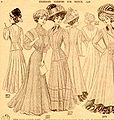
v – 1908
-

6 – 1909
-

7 – 1909
-

8 – 1909
- Golfing costume of 1907 features a tailored jacket and matching talocrural joint-length brim with patch pockets.
- Motoring required voluminous coats or dusters to go on clothes clean and wearers warm in open up automobiles. They were worn with stylish hats wrapped in veils, gloves, and frequently goggles, 1907.
- 1908 portrait past Paul Helleu captures the stylish combination of masses of wavy hair beneath a broad-brimmed hat.
- Dresses past Paul Poiret point the way to a new silhouette, with a high waist and narrow, ankle-length skirts, 1908.
- Paper insert of fashions for 1908 shows dresses of a more conservative cut than the latest Paris modes, but waists are higher and the figure slimmer and more than erect than in the first half of the decade.
- Bib-front apron with pouter-dove cutting, 1909.
- High-fashion costume of 1909 has a narrower silhouette. The bodice fits closer to the torso, although the waist still slopes, and the hat has a deep crown.
- Dresses of 1909 show the new fitted, higher-waisted silhouette and are worn with huge hats.
Men's fashion [edit]
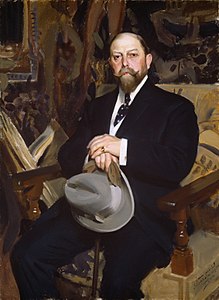
Hugo Reisinger wears a dark accommodate with a white waistcoat and dotted tie. He carries the fashionable Homburg hat, 1907, painting past Anders Zorn, 1907
The long, lean, and athletic silhouette of the 1890s persisted. Hair was generally worn short. Beards were less pointed than earlier and moustaches were frequently curled.
Coats, waistcoats and trousers [edit]
The sack coat or lounge coat continued to supervene upon the frock coat for about informal and semi-formal occasions. Three-piece suits consisting of a sack coat with matching waistcoat (U.S. vest) and trousers were worn, every bit were matching coat and waistcoat with contrasting trousers, or matching glaze and trousers with contrasting waistcoat. Trousers were shorter than earlier, oft had turn-ups or cuffs, and were creased front end and back using the new trouser press.[15]
Waistcoats fastened high on the chest. The usual style was single-breasted.
The blazer, a navy blue or brightly colored or striped flannel coat cut like a sack coat with patch pockets and brass buttons, was worn for sports, sailing, and other casual activities.
The Norfolk jacket remained fashionable for shooting and rugged outdoor pursuits. Information technology was fabricated of sturdy tweed or similar textile and featured paired box pleats over the chest and back, with a fabric belt. Worn with matching breeches or (U.South. knickerbockers), it became the Norfolk suit, suitable for bicycling or golf with genu-length stockings and low shoes, or for hunting with sturdy boots or shoes with leather gaiters.
The cutaway morn glaze was still worn for formal day occasions in Europe and major cities elsewhere, with striped trousers.
The most formal evening dress remained a dark tail coat and trousers with a dark or light waistcoat. Evening wear was worn with a white bow tie and a shirt with a winged collar. The less formal dinner jacket or tuxedo, which featured a shawl collar with silk or satin facings, now generally had a single button. Dinner jackets were advisable formal clothing when "dressing for dinner" at domicile or at a men's club. The dinner jacket was worn with a white shirt and a dark necktie.
Knee-length topcoats and calf-length overcoats were worn in wintertime.
Shirts and neckties [edit]
Formal apparel shirt collars were turned over or pressed into "wings". Collars were overall very tall and stiffened. Apparel shirts had stiff fronts, sometimes decorated with shirt studs and buttoned up the back. Striped shirts were pop for informal occasions.
The usual necktie was a narrow 4-in-mitt. Ascot ties were worn with formal day apparel and white bow ties with evening clothes.
Accessories [edit]
Elevation hats remained a requirement for upper grade formal wear; soft felt Homburgs or stiff bowler hats were worn with lounge or sack suits, and flat straw boaters were worn for casual occasions.
Shoes for men were by and large over the talocrural joint. Toe cap, lace upwardly boots in black, gray, or brown were the most common for everyday wear. Formal occasions called for formal boots with white uppers (spat style) and buttons on the side. In the Edwardian times basic lace upward oxford shoes were introduced.
Fashion gallery 1901−1905 [edit]
-

i – 1900
-

ii – 1900
-

3 - 1901
-

4 - c. 1902
-

5 – 1903
-

half-dozen - 1903
-

vii – 1904
-

8 – 1904
-

9 – 1905
- Antoni Wodzicki wears a fur-collared overcoat and a Homburg, 1900.
- Fashion illustration of a topcoat (left, worn with a top hat and forenoon clothes) and overcoat (right, worn with business wearing apparel and Homburg), December 1900.
- Style plate from the Sartorial Arts Journal shows a 3-button suite with patch pockets (left) and a golfing costume consisting of a Norfolk jacket and knickerbockers (right), 1901.
- Staffmembers of the Tuskegee Establish wear coats with high front openings and contrasting trousers, many striped, c. 1902.
- Portrait of Theodore Roosevelt by John Singer Sargent in a formal frock coat, 1903.
- Caricature of a fitting at Charvet in 1903.
- Portrait of Theodore Roosevelt in a vividly patterned tie, lite waistcoat, and dark coat, 1904. The very short hairstyle is typical of the period.
- Formal frock glaze, 1904.
- Two Irishmen in San Francisco wearing bowler hats, 1905.
Manner gallery 1906-1909 [edit]
-

1 – 1906
-

two - 1906
-

three – 1907
-

iv – 1907
-

5 - c. 1907
-

6 - 1907
-

7 – 1909
- Men's formal daywear consists of a cutaway forenoon glaze, high-buttoned waistcoat, and creased fly-front trousers worn with a high-collared shirt, top hat, and gloves, 1906.
- Photo William Randolph Hearst wears a glaze with a very loftier closure, a strong neckband, and a tie with a stickpin, 1906.
- John Singer Sargent wears a gray formal coat and a winged-collar shirt, 1907.
- Wilfrid Laurier, the Prime Minister of Canada and his married woman, 1907
- Photograph of William Howard Taft in a three-slice suit, c. 1907.
- British formal dress: David Lloyd George (left) and Winston Churchill wear frock coats and top hats, 1907.
- Irish immigrants in Kansas City, Missouri, 1909. The man second from the left is wearing a flat cap.
Children'southward way [edit]
Girls' fashion for this time menstruation imitated older women of the aforementioned period. Girls wore dresses of knee length, with trimmings at the hem such as lace and embroidery similar to women's lingerie dresses. Usually, black shoes or button up / lace up boots and woolen stockings went with the dress equally well as kidskin or crochet gloves. Their hair was generally worn long and curly with decorations of ribbon. For play, bloomers and woolen jerseys were acceptable.[16]
A new attempt was made to design garments that are more suitable for playing by designing girls' dresses with short sleeves.[17] Outside, button up boots would have been worn or lace up boots besides shoes with spats would have been worn in the winter spats worn over shoes created the expect of wearing a long kicking. Kid leather gloves would accept been worn to encompass the hands or lace gloves in the summertime. Bonnets were being replaced by hats past the end of the Victorian era then girls would have worn a hat when out.
Immature boys plant comfort in Russian fashion blouses.[17]
Fashionable clothing for boys included sailor suits, consisting of a shirt with a crewman collar and trousers or knickerbockers. For automobiling, boys wore a squeegee with knickerbockers, a flat cap, and goggles.[18]
-

Even tiny girls were dressed in big hats, 1900
-

Two French boys wearing knickerbockers, 1900
-

Girls' fashions for August 1901
-

Pocket-sized boy in a sailor suit, 1909
-

Olga Nikolaevna of Russian federation 1904
-

Olga, Tatiana, Maria and Anastasia Nikolaevna in Darmstadt, Hesse, 1903
-

School children from the Rainy River District, 1900s.
Working clothes [edit]
-

Aprons, from a 1909 catalogue
-

Housemaid ironing, 1908
-

Woman in a kitchen in the Rainy River Commune, ca. 1905.
See also [edit]
- Belle Époque
- Charvet Identify Vendôme
- Edwardian era
- History of style pattern
Notes [edit]
- ^ Laver, James: The Concise History of Costume and Manner, Abrams, 1979
- ^ Vintagefashionguild.org
- ^ 1634–1699: McCusker, J. J. (1997). How Much Is That in Real Money? A Historical Cost Index for Employ as a Deflator of Money Values in the Economy of the United States: Addenda et Corrigenda (PDF). American Antiquarian Club. 1700–1799: McCusker, J. J. (1992). How Much Is That in Real Money? A Historical Price Index for Use as a Deflator of Money Values in the Economy of the United States (PDF). American Antiquarian Society. 1800–present: Federal Reserve Depository financial institution of Minneapolis. "Consumer Toll Index (approximate) 1800–". Retrieved 1 January 2020.
- ^ Weed, Inis H. (24 Apr 1910). "What It Costs A Young Girl To Be Well Dressed". The New York Times . Retrieved 26 January 2011.
- ^ Development of Women's Fashion During the Progressive Era Examined in DAR Museum Exhibition. (xvi July 2014). Retrieved 17 Apr 2017
- ^ a b Tierney, T. (2017). Appropriation, articulation and hallmark in acid house: The evolution of women'south manner throughout the early years of the acid house culture. Fashion, Style, & Popular Culture, 4(two), 179. doi:10.1386/fspc.four.2.179_1
- ^ Fashion in History
- ^ Laver: Curtailed History of Costume and Fashion
- ^ Steele, Valerie: Paris Fashion: A Cultural History, Oxford University Press, 1988, ISBN 0-19-504465-7
- ^ Steele, Valerie: The Corset, Yale Academy Printing, 2001
- ^ Quoted in Steele, The Corset', p. 146
- ^ Ashelford, Jane: The Art of Dress.
- ^ Payne, Blanche: History of Costume from the Ancient Egyptians to the Twentieth Century, Harper & Row, 1965. No ISBN for this edition; ASIN B0006BMNFS
- ^ Donald Read, Edwardian England 1901-xv: society and politics (1972) pp. 257–58.
- ^ Laver, Concise History of Costume and Fashion
- ^ Stevenson, Pauline. Edwardian Fashion. London: Ian Allan LTD., 1980.
- ^ a b "Children'south Costume History 1900–1910" Archived ii May 2008 at the Wayback Machine Fashion-era.com. 28 Apr 2008
- ^ Children's Fashions, 1860–1912: 1065 Costume Designs from "La Mode Illustrée". New York: Dover Publications, Inc., 1994.
References [edit]
- Arnold, Janet: Patterns of Mode 2: Englishwomen'south Dresses and Their Structure C.1860–1940, Wace 1966, Macmillan 1972. Revised metric edition, Drama Books 1977. ISBN 0-89676-027-viii
- Ashelford, Jane: The Art of Dress: Wearable and Society 1500–1914, Abrams, 1996. ISBN 0-8109-6317-5
- Laver, James: The Curtailed History of Costume and Fashion, Abrams, 1979.
- Nunn, Joan: Fashion in Costume, 1200–2000, 2nd edition, A & C Black (Publishers) Ltd; Chicago: New Amsterdam Books, 2000. (Excerpts online at The Victorian Web)
- Steele, Valerie: Paris Manner: A Cultural History, Oxford University Press, 1988, ISBN 0-xix-504465-7
- Steele, Valerie: The Corset, Yale University Press, 2001
External links [edit]
-
 Media related to 1900s style at Wikimedia Eatables
Media related to 1900s style at Wikimedia Eatables - "1900s - 20th Century Fashion Drawing and Illustration". Style, Jewellery & Accessories. Victoria and Albert Museum. Archived from the original on 19 November 2010. Retrieved iii April 2011.
- 1900s Way Plates of men, women, and children's fashion from The Metropolitan Museum of Art Libraries
- 1900s era Henri Bendel Way Sketch Collection at the Brooklyn Museum
Surviving clothing [edit]
- Lingerie dresses at Kent State University
- 1900-1910 Fashions in the Staten Island Historical Society Online Collections Database
0 Response to "Early 1900 Men's Fashion No Jacket"
Post a Comment